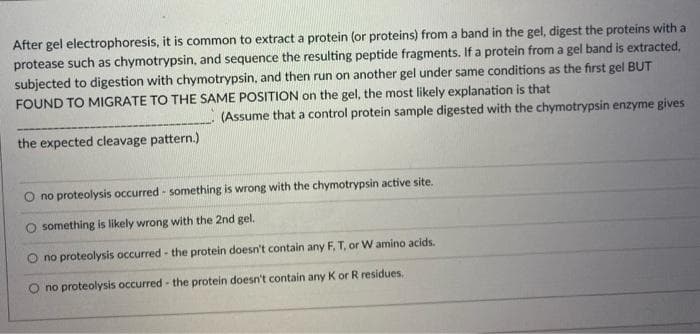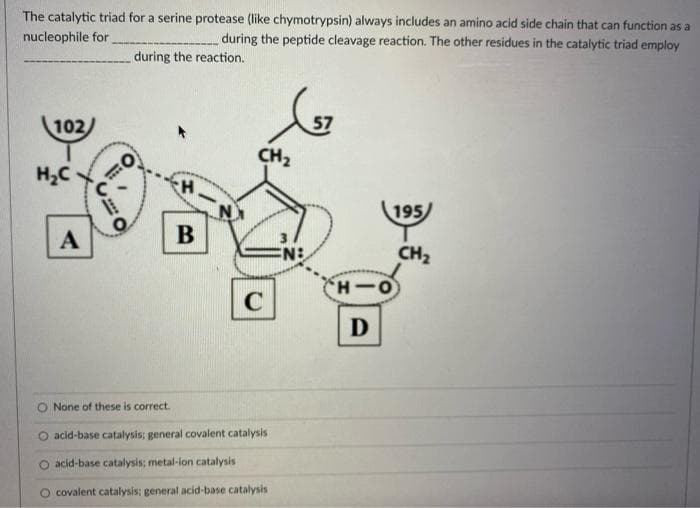After gel electrophoresis, it is common to extract a protein (or proteins) from a band in the gel, digest the proteins with a protease such as chymotrypsin, and sequence the resulting peptide fragments. If a protein from a gel band is extracted, subjected to digestion with chymotrypsin, and then run on another gel under same conditions as the first gel BUT FOUND TO MIGRATE TO THE SAME POSITION on the gel, the most likely explanation is that (Assume that a control protein sample digested with the chymotrypsin enzyme gives the expected cleavage pattern.) no proteolysis occurred - something is wrong with the chymotrypsin active site. something is likely wrong with the 2nd gel. no proteolysis occurred - the protein doesn't contain any F, T, or W amino acids. no proteolysis occurred - the protein doesn't contain any K or R residues.
After gel electrophoresis, it is common to extract a protein (or proteins) from a band in the gel, digest the proteins with a protease such as chymotrypsin, and sequence the resulting peptide fragments. If a protein from a gel band is extracted, subjected to digestion with chymotrypsin, and then run on another gel under same conditions as the first gel BUT FOUND TO MIGRATE TO THE SAME POSITION on the gel, the most likely explanation is that (Assume that a control protein sample digested with the chymotrypsin enzyme gives the expected cleavage pattern.) no proteolysis occurred - something is wrong with the chymotrypsin active site. something is likely wrong with the 2nd gel. no proteolysis occurred - the protein doesn't contain any F, T, or W amino acids. no proteolysis occurred - the protein doesn't contain any K or R residues.
Human Anatomy & Physiology (11th Edition)
11th Edition
ISBN:9780134580999
Author:Elaine N. Marieb, Katja N. Hoehn
Publisher:Elaine N. Marieb, Katja N. Hoehn
Chapter1: The Human Body: An Orientation
Section: Chapter Questions
Problem 1RQ: The correct sequence of levels forming the structural hierarchy is A. (a) organ, organ system,...
Related questions
Question
Can someone please help me with these two questions, please hurry I only have 45 minutes;

Transcribed Image Text:After gel electrophoresis, it is common to extract a protein (or proteins) from a band in the gel, digest the proteins with a
protease such as chymotrypsin, and sequence the resulting peptide fragments. If a protein from a gel band is extracted,
subjected to digestion with chymotrypsin, and then run on another gel under same conditions as the first gel BUT
FOUND TO MIGRATE TO THE SAME POSITION on the gel, the most likely explanation is that
(Assume that a control protein sample digested with the chymotrypsin enzyme gives
the expected cleavage pattern.)
O no proteolysis occurred - something is wrong with the chymotrypsin active site.
something is likely wrong with the 2nd gel.
no proteolysis occurred - the protein doesn't contain any F, T, or W amino acids.
no proteolysis occurred - the protein doesn't contain any K or R residues.

Transcribed Image Text:The catalytic triad for a serine protease (like chymotrypsin) always includes an amino acid side chain that can function as a
during the peptide cleavage reaction. The other residues in the catalytic triad employ
nucleophile for
during the reaction.
102/
57
CH2
H2C
195)
А
B
N:
CH2
D
None of these is correct.
O acid-base catalysis; general covalent catalysis
O acid-base catalysis; metal-lon catalysis
O covalent catalysis: general acid-base catalysis
Expert Solution
This question has been solved!
Explore an expertly crafted, step-by-step solution for a thorough understanding of key concepts.
This is a popular solution!
Trending now
This is a popular solution!
Step by step
Solved in 2 steps

Knowledge Booster
Learn more about
Need a deep-dive on the concept behind this application? Look no further. Learn more about this topic, biology and related others by exploring similar questions and additional content below.Recommended textbooks for you

Human Anatomy & Physiology (11th Edition)
Biology
ISBN:
9780134580999
Author:
Elaine N. Marieb, Katja N. Hoehn
Publisher:
PEARSON

Biology 2e
Biology
ISBN:
9781947172517
Author:
Matthew Douglas, Jung Choi, Mary Ann Clark
Publisher:
OpenStax

Anatomy & Physiology
Biology
ISBN:
9781259398629
Author:
McKinley, Michael P., O'loughlin, Valerie Dean, Bidle, Theresa Stouter
Publisher:
Mcgraw Hill Education,

Human Anatomy & Physiology (11th Edition)
Biology
ISBN:
9780134580999
Author:
Elaine N. Marieb, Katja N. Hoehn
Publisher:
PEARSON

Biology 2e
Biology
ISBN:
9781947172517
Author:
Matthew Douglas, Jung Choi, Mary Ann Clark
Publisher:
OpenStax

Anatomy & Physiology
Biology
ISBN:
9781259398629
Author:
McKinley, Michael P., O'loughlin, Valerie Dean, Bidle, Theresa Stouter
Publisher:
Mcgraw Hill Education,

Molecular Biology of the Cell (Sixth Edition)
Biology
ISBN:
9780815344322
Author:
Bruce Alberts, Alexander D. Johnson, Julian Lewis, David Morgan, Martin Raff, Keith Roberts, Peter Walter
Publisher:
W. W. Norton & Company

Laboratory Manual For Human Anatomy & Physiology
Biology
ISBN:
9781260159363
Author:
Martin, Terry R., Prentice-craver, Cynthia
Publisher:
McGraw-Hill Publishing Co.

Inquiry Into Life (16th Edition)
Biology
ISBN:
9781260231700
Author:
Sylvia S. Mader, Michael Windelspecht
Publisher:
McGraw Hill Education